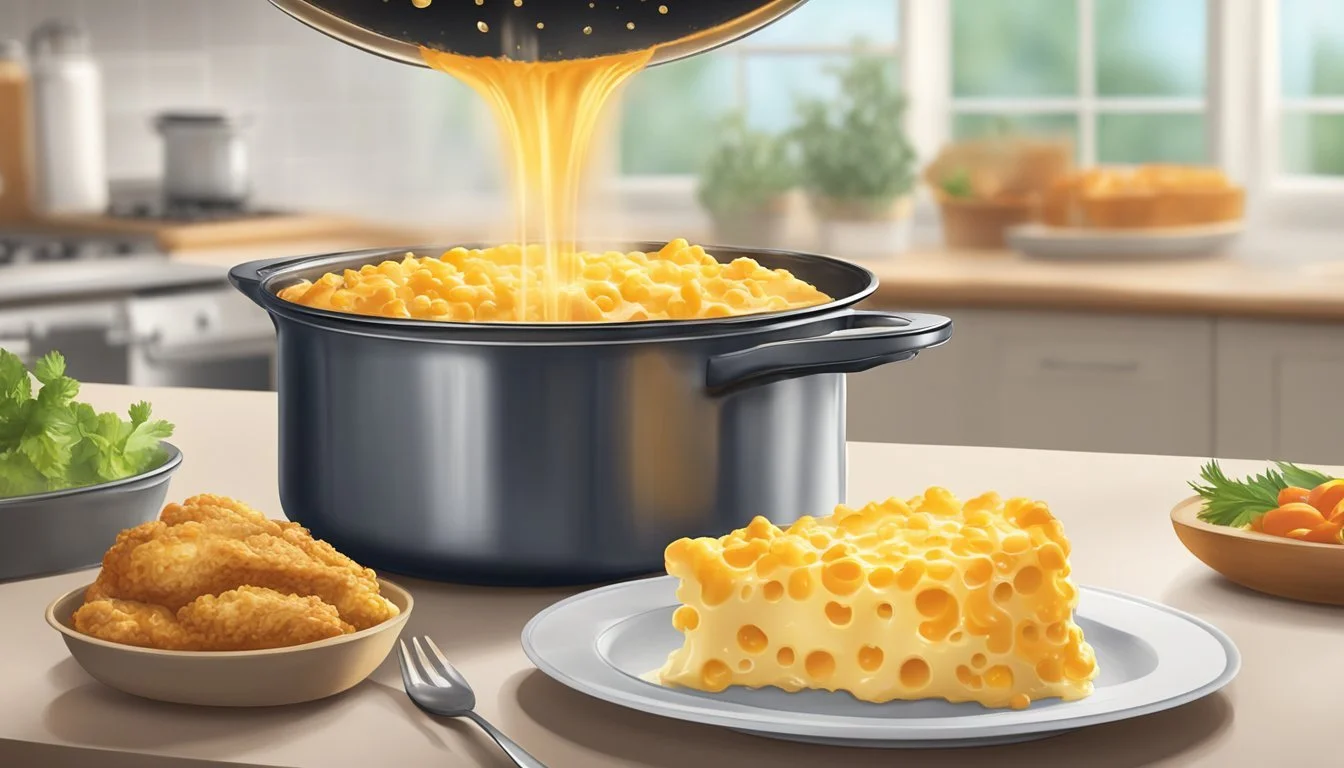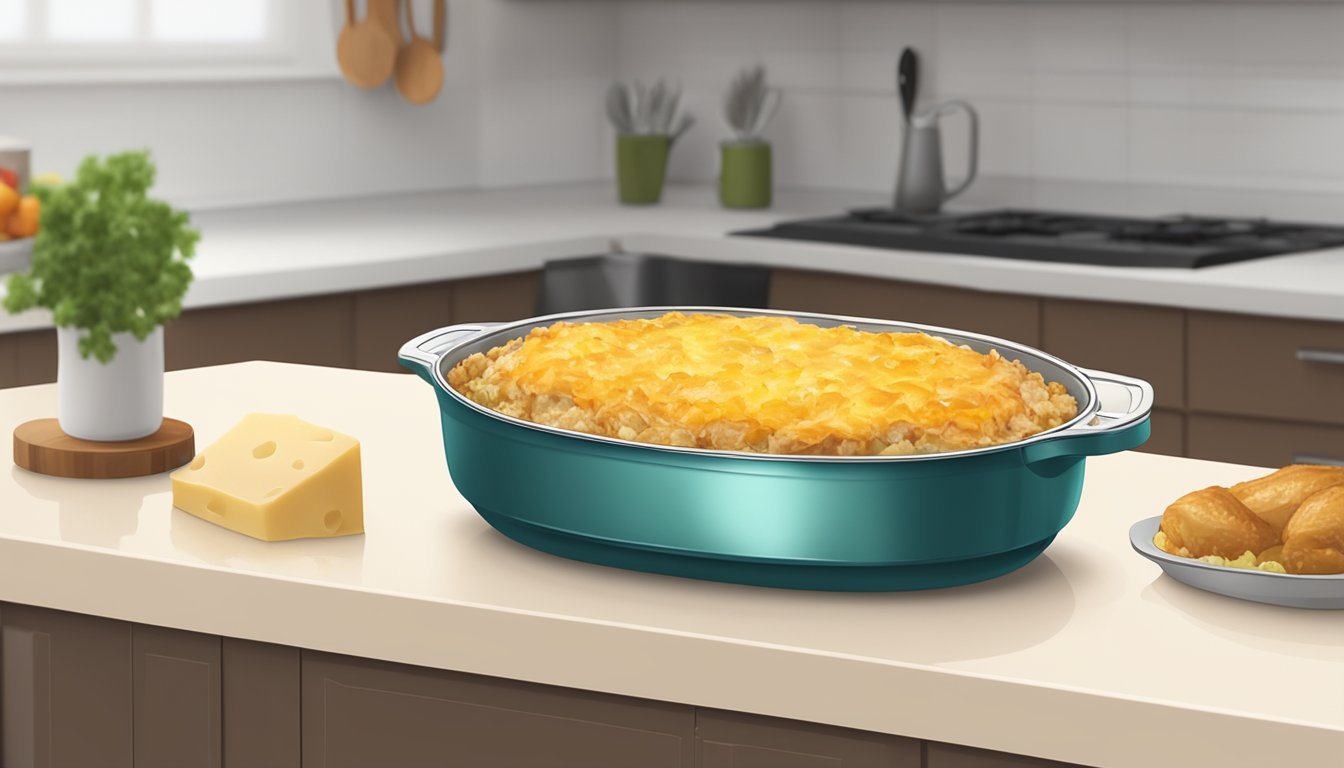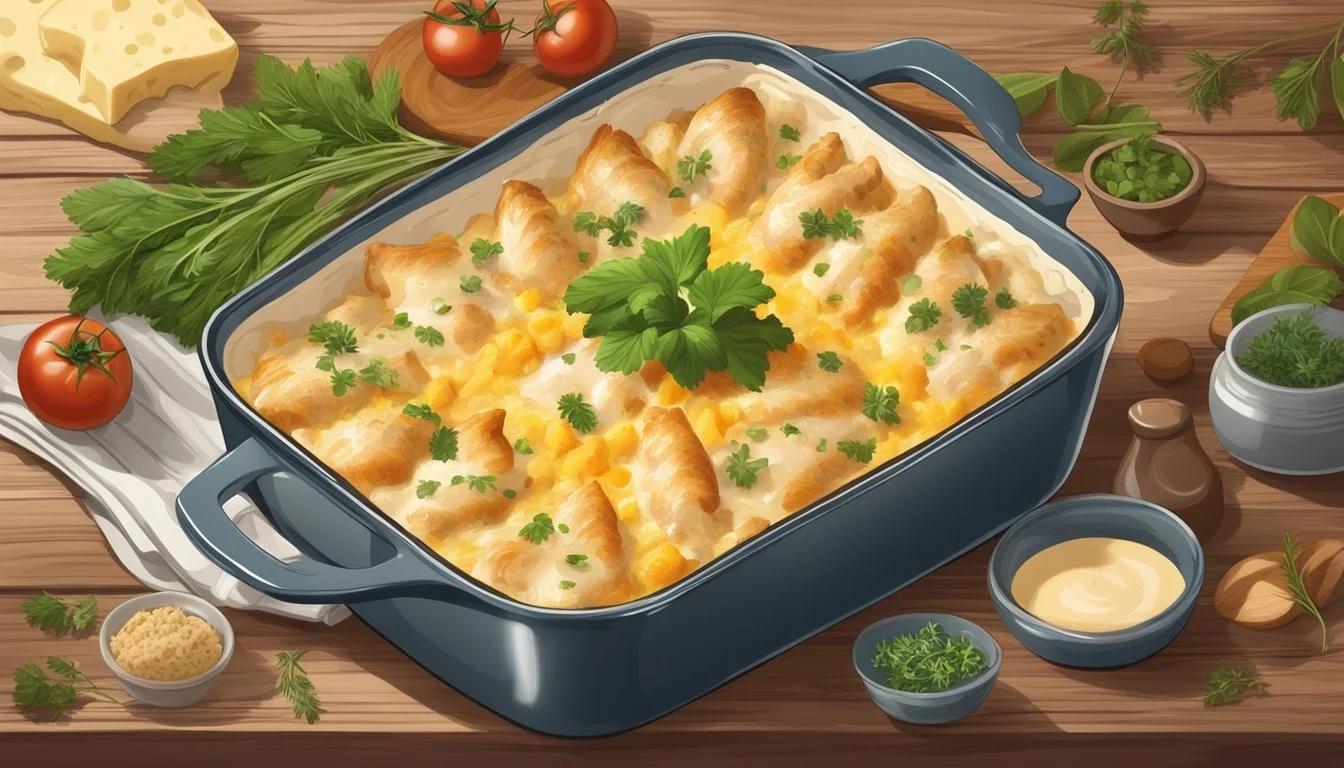How Long Does Chicken and Cheese Casserole Last?
Storage Tips and Shelf Life
Cooking a delicious chicken and cheese casserole can be an enjoyable experience, but knowing how long you can safely enjoy those leftovers is crucial. A properly stored chicken and cheese casserole lasts 3 to 4 days in the refrigerator. This period ensures that the meal remains safe to eat and retains its flavor and texture.
For those looking to extend the lifespan of their culinary creation, freezing is an excellent option. When stored in an airtight container, a chicken and cheese casserole can be frozen for up to 2 to 3 months. Reheating and enjoying this savory dish is simple, making meal prep and planning a breeze.
These guidelines help maintain food safety and quality, allowing everyone to savor the casserole without worry.
Essentials of Casserole Preparation
Creating the perfect chicken and cheese casserole involves selecting the best ingredients and following meticulous assembly and baking steps. Each choice made during preparation impacts the flavor and texture, ensuring a delicious and satisfying dish.
Choosing the Right Ingredients
Selecting top-quality ingredients is crucial. Start with fresh chicken, such as boneless, skinless chicken breasts or thighs. Cut the chicken into bite-sized pieces for even cooking. Incorporate vegetables like broccoli and carrots for added nutrition and flavor.
Use a combination of cheeses, including cheddar, mozzarella, and parmesan, to achieve a rich and creamy texture. Cream of chicken soup and milk form the base of the sauce, providing a smooth consistency. Garlic and pepper enhance the overall taste, adding an extra layer of complexity.
Complement the casserole with cooked rice for a hearty meal. Ensure all ingredients are measured accurately to maintain the desired flavor balance.
Casserole Assembly and Baking Instructions
Begin by preheating the oven to the required temperature, usually 350°F (175°C). Lightly grease a casserole dish or baking dish with cooking spray or melted butter.
Layer the cooked rice evenly at the bottom of the dish. Spread the cubed chicken over the rice, followed by the veggies like broccoli and carrots. In a separate bowl, whisk together cream of chicken soup, milk, minced garlic, and a pinch of pepper until smooth. Pour this mixture over the layered ingredients in the dish.
Sprinkle the grated cheeses (cheddar, mozzarella, parmesan) generously on top. Cover the dish with aluminum foil and bake for around 45 minutes to 1 hour, or until the chicken reaches an internal temperature of 165°F (74°C). For a golden-brown crust, remove the foil during the last 10 minutes of baking.
Proper Storage Techniques
To ensure your chicken and cheese casserole retains its flavor and stays safe to eat, it is essential to store it correctly. Key methods include refrigeration for short-term storage and freezing for long-term preservation.
Storing Fresh Casserole
Properly storing a freshly baked chicken and cheese casserole starts with allowing it to cool. Once it has reached room temperature, transfer the casserole into an airtight container or tightly wrap the casserole dish with plastic wrap or aluminum foil. This process helps to prevent the dish from drying out or absorbing other odors in the refrigerator.
Store the casserole in the refrigerator at or below 40°F (4°C). A chicken and cheese casserole typically remains fresh for up to 3-4 days when kept under these conditions. Another key tip is to avoid storing it with ingredients like broccoli unless you plan to consume it within a day or two, as fresh vegetables can degrade quickly.
Labeling your container with the date of preparation can be helpful to manage the freshness of your dish. If you plan to use leftovers, reheat them using an oven or microwave until the internal temperature reaches at least 165°F (74°C) to ensure food safety.
Freezing and Thawing Casserole
For longer-term storage, freezing is the best option. Transfer the casserole to a freezer-safe airtight container or use heavy-duty aluminum foil to wrap the casserole dish. Ensure no parts are exposed to prevent freezer burn, which can impact flavor and texture.
A properly-frozen chicken and cheese casserole will last for 2-3 months in the freezer. When you are ready to eat it, thaw the casserole in the refrigerator for 24-48 hours. Avoid thawing it at room temperature or in the microwave as this can promote bacterial growth.
After thawing, reheat the casserole in an oven preheated to 350°F (175°C) until it reaches an internal temperature of 165°F (74°C). This gradual thaw and reheating process help maintain the casserole’s texture and flavor. Properly cooked and stored casseroles ensure safe and enjoyable meals even after extended storage periods.
Serving and Reheating
Chicken and cheese casserole is a delicious option for quick, weeknight dinners. It's easy to make, serves well with a side salad, and can be conveniently reheated for a family dinner.
Serving Suggestions
Chicken and cheese casserole can be served in many appealing ways. For a simple weeknight meal, pair it with a light side salad. A mix of fresh greens, tomatoes, and cucumbers complements the rich, cheesy casserole. Consider adding a vinaigrette dressing for a tangy balance.
For a fuller meal, serve the casserole with crusty bread or garlic toast. These additions provide a satisfying crunch. Alternatively, steamed vegetables like broccoli or green beans can make the meal even more wholesome. For larger gatherings, serve the casserole in a decorative baking dish to enhance presentation.
Reheating Your Casserole
Reheating properly is crucial to maintain the taste and texture of your chicken and cheese casserole. For oven reheating, preheat the oven to 350°F (175°C). Remove the casserole from the refrigerator and let it sit at room temperature for about 30-60 minutes. Cover the dish with aluminum foil to prevent drying out.
Place the covered dish in the preheated oven. Bake for 20-30 minutes if the casserole is in small pieces or up to an hour if it is a thicker serving. Ensure it reaches an internal temperature of 165°F before serving. In a rush, the microwave can be a quick method. Heat individual portions on high for 1-2 minutes, checking frequently to avoid uneven heating.
Safety and Food Quality
Storing and consuming chicken and cheese casserole involves understanding its lifespan and recognizing spoilage signs. Safety and quality can be compromised if not handled properly.
Determining Casserole Lifespan
Chicken and cheese casserole should be stored in a refrigerator at or below 40°F (4°C). In the fridge, it typically lasts 3-4 days. For extended storage, freezing is a great option—up to 2-3 months at 0°F (-18°C) or lower.
Keep casseroles in airtight containers to prevent contamination and maintain quality. Labeling containers with dates also helps in tracking usage time. Following the FDA guidelines ensures the casserole remains safe and delicious longer.
Identifying Spoilage Signs
Spoiled casserole often exhibits distinct signs. Smell is a primary indicator; if it has a sour or off odor, discard it. Color changes to grayish or greenish could mean mold or bacterial growth.
Texture plays a role too; if the casserole becomes slimy or excessively dry, it’s likely unsafe. Visible mold growth, even in small patches, means it’s time to throw it out. Regularly check for these signs to ensure food remains safe to eat.
Flavor and Texture Enhancements
Enhancing the flavor and texture of a chicken and cheese casserole is essential for a delicious and satisfying dish. Focusing on the right ingredients and methods can make a significant difference.
Ingredients for Added Flavor
The flavor of a chicken and cheese casserole can be elevated using a few key ingredients. Garlic powder, salt, and pepper serve as fundamental seasoning agents. These can be enhanced further with additional spices like paprika or thyme for depth.
Incorporating cheddar cheese adds a bold, tangy profile that pairs well with chicken. For a slightly sweet and complex flavor, consider adding caramelized onions or sweet bell peppers. They provide a nice contrast and deepen the overall taste of the dish.
A tablespoon of butter melted and mixed into the casserole can impart a rich, buttery essence. Using a variety of herbs such as parsley or chives as a garnish adds a fresh note just before serving.
Creating a Creamy Texture
Achieving a creamy texture in your casserole involves selecting the right components and cooking techniques. A common method is to use cream of chicken soup as a base. It contributes a smooth, thick consistency.
Mix the soup with milk to enhance its creaminess. For an even richer texture, blend in sour cream or cream cheese. These dairy products add a luscious, smooth mouthfeel to the casserole.
Making a simple roux by combining melted butter and flour can also thicken the sauce. Gradually stir in the milk and cheddar cheese to achieve a silky, creamy sauce. Cooking the roux until it gains a slightly nutty aroma before adding liquids ensures the best results.
Sprinkle a final layer of cheese on top before baking for that perfect, cheesy finish.
Customization Ideas
A chicken and cheese casserole is versatile, allowing for various tweaks to fit different dietary needs and personal preferences. Adjusting proteins, vegetables, and the base can make your casserole unique and delicious every time.
Protein and Vegetable Variations
Experimenting with protein options like turkey or tofu provides different flavors and nutritional benefits. Turkey can be used as a leaner alternative, while tofu suits a vegetarian diet.
Variations with vegetables include adding spinach, broccoli florets, or a mix of favorite veggies. Spinach adds a nutrient boost and color, while broccoli florets offer a crunchy texture.
It's also possible to use combinations of chicken breasts with other veggies like bell peppers, carrots, and peas. Mixing in different vegetables not only enhances the taste but also increases the dish's nutritional value.
Alternative Casserole Bases
Several alternatives to the traditional base of rice or pasta can change the texture and flavor profile of your casserole. Quinoa is an excellent substitute for a higher protein and fiber content.
For a unique twist, use mashed potatoes as a base, providing a creamy and comforting layer. This works well with meatless versions, adding richness and depth.
Another alternative is using whole grains like barley or farro, adding a hearty texture. These grains can be combined with chicken or turkey and mixed veggies to create a balanced, nutritious meal.
Making these adjustments can refresh the classic casserole, offering new tastes and health benefits with every modification.
Additional Cooking Tips
Incorporating these cooking tips will enhance the flavor and convenience of your chicken and cheese casserole. Focus on efficient preparation and appropriate portion control for a hassle-free, enjoyable meal.
Preparation and Cooking Shortcuts
For a quick prep, use pre-cooked diced chicken and frozen broccoli.
These items significantly reduce cooking time. Pre-cooked diced chicken can be found in most grocery stores and saves the step of cooking and cutting the chicken.
Frozen broccoli is available year-round and doesn't require chopping or blanching.
Opt for instant rice instead of traditional rice to speed up the process. Instant rice cooks in minutes and works well in casseroles.
Consider one-pot cooking methods. Combine all ingredients in a single dish to minimize cleanup time.
Use shredded cheese from a bag to save the effort of grating.
Serving Sizes and Portion Control
Portion sizes are key, especially when serving a family dinner or accommodating kids.
A typical serving for adults is about 1 to 1.5 cups of casserole. Kids may need half this amount.
For balanced meals, incorporate hearty sides like cornbread or a simple salad.
When preparing the casserole, consider dividing it into individual portions before baking. This method ensures everyone gets an equal share.
Use a serving size guide:
1 cup scoop for adults
0.5 cup scoop for kids
This measure helps in maintaining consistency.
Freezing individual portions for future meals is another effective strategy, making it easy to reheat and serve as needed.
Inspiration from Other Dishes
Drawing inspiration from diverse culinary traditions and favorite comfort foods can give a unique twist to a classic chicken and cheese casserole.
Casserole Inspired by International Cuisines
Incorporating elements from international cuisines can transform a standard casserole. For example, Mexican-inspired casseroles often include ingredients like black beans, corn, and a blend of spices, topped with cheddar cheese and baked until bubbly.
Italian-inspired versions might feature a blend of mozzarella and parmesan cheese, along with marinara sauce, basil, and garlic. These additions can bring new flavors and textures to a familiar dish.
Asian-influenced casseroles might use soy sauce, ginger, and green onions, paired with rice and baked chicken. Such adaptations not only diversify the dish but also make it accessible to a variety of palates.
Combining the Casserole with Other Favorites
Combining a chicken and cheese casserole with elements from other popular comfort foods can create exciting variations. Pizza-inspired casseroles can include pepperoni, marinara sauce, and a mix of mozzarella and parmesan, creating a lasagna-like dish that combines the best of both worlds.
Rotisserie chicken can be an excellent base for casseroles, offering convenience and rich flavor. Using leftover chicken from previous meals can also enhance the dish, making it both economical and tasty.
Baked potato toppings such as bacon, green onions, and cheddar cheese can be mixed into the casserole for a hearty and satisfying meal. This blend of elements from different dishes can satisfy various cravings and provide a sense of comfort, enhanced by the familiar tastes of beloved foods.
Final Thoughts
Chicken and cheese casserole is a practical and delicious option for busy individuals and families. It offers the convenience of being easy to make and can be stored properly for optimal safety and taste.
Why Casseroles Are a Great Meal Option
Casseroles, like chicken and cheese casserole, are well-loved for their warmth and comfort. The cheesy layers combined with tender chicken make it a satisfying comfort food that appeals to all ages. These dishes are perfect for family dinners, bringing everyone together around the table.
Preparing a casserole can be simple and time-effective. Most casseroles can be made in one dish, reducing the need for excessive cleanup. The ability to store leftovers for 3-4 days in the fridge ensures you have delicious meals ready to go, cutting down on daily cooking time.
Families appreciate casseroles for their versatility and the plethora of ingredients you can include. Whether it's vegetables, proteins, or spices, casseroles can be customized to everyone's liking, making them an irresistible choice for any meal.









